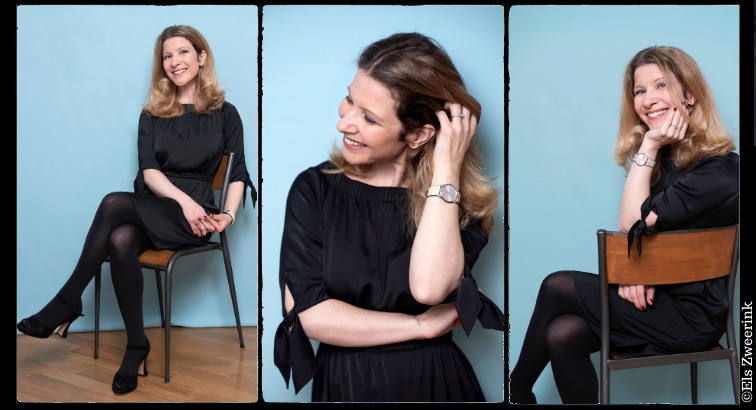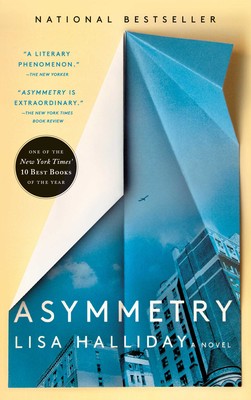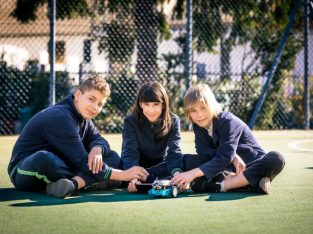A Conversation with Lisa Halliday, an American Writer in Milan
The American writer Lisa Halliday, winner of a 2017 Whiting Award for Fiction, walks the cobblestoned streets and lanes of Milan pondering her work. Looking up at the golden Madonnina, or passing the imposing, marble-clad façade of the Palazzo di Giustizia, she considers alternative scenarios, her imagination traces new plots.
She returns to her sparsely decorated studio in the city center and begins giving substance to the vision. A plank of wood on A-frame stilts, a few maps, and piles of books are her only companions as she writes. Her phone is an old-fashioned Nokia that offers little in the way of distraction. It’s as if she’s working on a secret project.
Halliday’s first “secret” has been out for a while. Her debut novel, Asymmetry, a fictional “triptych” that explores the power plays and imbalances of contemporary life, received critical acclaim and was selected as one of The New York Times Book Review’s 10 Best Books of 2018.
Originally from Massachusetts, Halliday came to Milan in 2011 with her husband, who works for an Italian publishing house. Since moving here, Halliday has had a daughter and made the shift from freelance work to writing full-time. Her latest piece, which appeared in Granta Magazine last July, is an introduction to photographs taken by Wiktoria Wojciechowska of Mussolini’s Pontine Marsh cities, between Rome and Naples, not far from where Halliday has relatives in Campania.
Lisa Halliday was kind enough to sit down with Easy Milano (virtually) and answer some of our questions about her life, her work, and how Milan has influenced and inspired her.
How did you end up in Milan?
My husband is British; we met when we worked for the same literary agency, which has offices in London and New York. We married in 2009, and the following spring I moved from Manhattan to London. A few months later, my husband received an offer to work for the Italian publishing house Feltrinelli, in Milan. I have Italian ancestry and in college my focus was on Italian Renaissance art. My husband studied French and Italian literature at university, and during that time he also lived in Rome. So we each had a background in Italian language and culture and when the opportunity presented itself we decided to accept. We’ve been here now ten years.
Where else have you lived?
I grew up in Medfield, Massachusetts. I then lived in Cambridge and Somerville while I was in college. After graduating I moved to Manhattan and lived on the Upper West Side for nearly a decade. Then I moved to Europe.
What do you love most about living in Milan? Miss most about living in the US?
The dramatic beauty of so much of Italy is a kind of nourishment. And the perspective that living abroad affords you, as both a writer and a citizen, is invaluable. But I miss my family, especially now that I have a child. Because of the pandemic, we have not seen my mother, sister, stepmother, and other American relatives for more than a year. After losing three family members and a close friend who all died between November 2016 and January 2019, I am more aware than ever of the importance, indeed the urgency, of spending time with those you love while you still can.
What are the differences between America and Italy that strike you?
One of the starkest differences is health care. The sweeping provision of affordable health care here fills me with wondrous gratitude, admiration, and bafflement at American resistance to the idea. In America, after leaving my job in order to try to become a writer, I could barely pay my rent, never mind an additional several hundred dollars a month for health insurance. I experienced chronic anxiety that I would have a medical emergency and no way to pay for it. Here there is no such anxiety. One still worries about medical emergencies, of course, but not how to pay for them. Like many of the differences, cultural and political, this one has to do with anti-government notions of freedom and a trenchant fealty to capitalism, attitudes not absent in Italy but that do seem more prominent and pervasive in America.
As expats living in a different culture, we often feel “integrated, yet out of place.” Do you ever feel like this?
Yes. But I don’t mind the feeling. I think I’ve always felt a version of it, even as a child, in my hometown. You can feel integrated and still anomalous, or incongruous, wherever you are, whatever the ambient culture. It’s as much a matter of feeling unable or unwilling to conform as it is about geographical coordinates.
Certainly, America has a different orientation in my mind as a result of my living outside it. I don’t mean to say I see it more or less critically: for each criticism one can name a virtue, a way in which America rightly serves as an ideal. But inevitably I now see it as an outsider. The implicitly political nature of Asymmetry was undoubtedly informed in part by my experience as an expatriate—although the term “expatriate” can have a slightly negative connotation, a hint of the unpatriotic, the drifter, the homeland-deserter, none of which I perceive in myself. I cannot defend everything about America, but I still feel gratefully affiliated with it. And, yes, patriotic.
Has living in Italy influenced your writing?
Of course. Most obviously with the specific details it offers up, the exposure to Italian art, music, history, and literature. Calvino is an influence, in particular his prescriptions in Six Memos for the Next Millennium (in Italian Lezioni americane, coincidentally) concerning lightness and multiplicity. And my background in the Italian visual arts, in images and form, almost certainly has something to do with Asymmetry being structured as it is, like a triptych. But there is also the influence of Italy’s relative remoteness to England and America. A remoteness that is psychological as well as geographical. In Italy, writing my first novel, I felt clandestine, almost anonymous. This made it easier to write less self-consciously, to privilege the story and the reader rather than myself. Whereas in New York and London, the centers of Anglophone publishing, my mere awareness of the industry’s proximity could sometimes feel oppressive. There is also the linguistic influence: learning Italian, living with it, has expanded and refined the ways I use English, too. Learning to speak a new language increases your etymological knowledge, your awareness of cognates and shared Latin roots. The result is a richer, more nuanced vocabulary, not only in the new language but in your native language as well. If I’m trying to find the right word in English to describe something, sometimes I’ll look to the Italian word and its origin and this will remind me of an English cognate or synonym that turns out to be the word I was looking for all along.
What are some of your favorite places in Milan? In Italy?
The list hails from a pre-pandemic existence, of course, but here it is anyway:
In Milan: I have special affection for the Poldi Pezzoli and Bagatti-Valsecchi museums, because I wrote my college thesis about them. I have also spent many rewarding hours in the Villa Necchi, the Museo Novecento, the Gallerie d’Arte, the Palazzo Reale, and the Palazzo Morando; the churches of Sant’Alessandro and San Maurizio al Monastero Maggiore; B Café, Le Rosse, and Banco; the beautiful old Feltrinelli offices in Via Andegari and Feltrinelli’s dazzling new building and bookshop in Viale Pasubio; Verso Bookstore; Cinema Mexico; the Saturday market in Via Tabacchi; and the Quadrilatero at Christmastime.
And, of course, La Scala. Our first apartment in Milan was right around the corner from La Scala and when our windows were open we could hear musicians rehearsing in the practice rooms nearby. Our proximity also made it easy to wait in line for cheap day-of tickets. In 2014 my husband and I went to hear Maurizio Pollini play Beethoven and Stockhausen and the program became the same music two characters in Asymmetry hear at a concert on Shelter Island.
Italy beyond Milan: Lago d’Orta and the Langhe.
Where do you go for inspiration?
It’s rare that I go looking for it, but I almost always find myself inspired in museums, most recently at a photography exhibit at the Palazzo Morando called Milano Anni ’60: Storia di un decennio irripetibile. I went with my husband and daughter and then I went back a second time alone and took notes. The exhibit closed early last year, but I think the catalogue is still available from Milano in Mostra, and I urge anyone with an interest in Milan or the 1960s to seek it out.
What do you consider a “must see/must do” for someone visiting Milan?
In addition to the main attractions (the Duomo, the Galleria, the Castello, La Scala, The Last Supper, Brera, the Navigli) I always send friends to the aforementioned San Maurizio al Monastero Maggiore, which I have heard referred to as The Sistine Chapel of Milan—except unlike the Sistine Chapel it is often empty, and free; you can walk in right off the street. It’s on Corso Magenta, next to the archeological museum and the Circo Romano; it’s also conveniently close to the beautiful Marchesi pasticceria and bar on Via Santa Maria alla Porta.
Tell us a little about your book Asymmetry.
It’s a novel in three parts. The first part (“Folly”) is set in New York and is a love story of sorts: between Alice, a young aspiring writer, and Ezra, a much older, very famous novelist. The second part (“Madness”) is narrated by Amar, an Iraqi-American economist who is detained at Heathrow on his way to see his brother in Kurdistan. The two parts are very different, in both content and style, but they are also subtly connected, and the link is hinted at in the novel’s coda (“Ezra Blazer’s Desert Island Discs”). There are also many themes that build and echo, as in music, throughout the three parts, and ultimately the novel asks: Can we ever really penetrate the looking-glass to imagine a life, a consciousness, seemingly very different from our own?
They say, “to be a good writer you must be a good reader.” What do you read? What are you reading now?
I recently finished the journals of Sylvia Plath. Before that I read Family Lexicon by Natalia Ginzburg, Weather by Jenny Offill, Intimations by Zadie Smith, and I re-read Updike’s Rabbit is Rich and Rabbit at Rest. Now I am reading everything I can by Richard Yates, and I am almost always in the middle of a magazine article or book review: piles of The New York Review of Books, The London Review of Books, and The New Yorker are ubiquitous in our home. My daughter likes to color the little line drawings and cartoons.
I know you have worked many years in the publishing industry. What did you learn from your experience as an agent?
Working in publishing was a pleasure and a privilege, a thrilling period that was both an invaluable education and a vigorous whetting of my work ethic. It also resulted in some of my most treasured friendships, including with Philip Roth, Frederick Seidel, Louise Erdrich, and Louise Glück. And, of course, my husband. On a more practical level, I learned to take my time writing my first novel, to wait until I felt it was well and truly finished, the very best I could make it, before submitting it to an agent.
What is your next book project?
I am working on another novel, which will be set partly in Milan, partly in New England, partly in New York, and (I think) partly in Calabria and Campania, where some of my maternal ancestors are from. It will explore the methods and emotions that underpin our attempts to ascertain what is “real” or “true,” specifically in the context of conspiracy theories and their Italian cousin, dietrologia. Complicating matters is that the truth is often evasive by nature; there is maddeningly infinite subjectivity in perception. And yet, to quote Edmund White: “Most people know that the truth is something like a horizon; it’s something you head toward. Maybe you never get there, but at least you have a sense of direction.”
Asymmetry is available in both English and Italian at local bookstores as well as on Amazon and other online outlets.
Article by Celia Abernethy, Easy Milano
Photos courtesy of Lisa Halliday, ©Els Zweerink
Comments (2)
You must be logged in to post a comment.






[…] Originally published by Easy Milano Jan 13, 2021 […]
[…] A Conversation with Lisa Halliday, an American Writer in Milan Author Jennifer Anton Reveals Under the Light of the Italian Moon […]